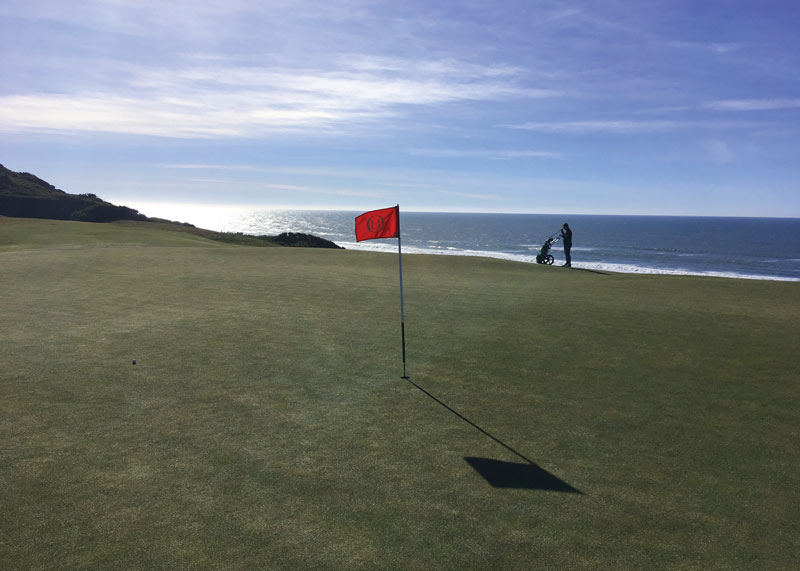
Figure 1. This golf course putting green at the Old MacDonald Golf Course in Bandon, Ore., is composed primarily of fine fescues. Photo by Aaron Patton
Editor’s note: This article is the third in a series about fine fescues on golf courses. Read the previous two installments: Classifying fine fescues used on golf courses, and Fine fescues on golf courses: Availability, establishment, management.
The five fine fescue grasses commonly used in turfgrass systems include strong creeping red fescue (Festuca rubra subspecies rubra), slender creeping red fescue (Festuca rubra subspecies littoralis), Chewings fescue (Festuca rubra subspecies commutata), sheep fescue (Festuca ovina) and hard fescue (Festuca brevipila) (Table 1).
These five grasses are of interest because of their low-input (nitrogen fertilizer, irrigation and pesticide) characteristics (Figure 1, above). These turfgrasses are being intensively studied by a team of researchers working on a grant titled “Increasing Low-Input Turfgrass Adoption through Breeding, Innovation, and Public Education” from USDA-NIFA through the Specialty Crop Research Initiative.
Abiotic stresses, which are stresses from nonliving things, affect all turfgrass species, including fine fescues. However, some fine fescue taxa are able to tolerate or resist a number of abiotic stresses better than others. In this, the third article of our four-part series, we will discuss differences in abiotic stress (for example, drought, submersion, heat, traffic, salinity, shade) tolerance of the five fine fescues.
Water stress
Water stress can occur in turfgrass swards when there is too little (drought) or too much (submerged, flooded, poorly drained) water (Figures 2, 3). Overall, compared with many other cool-season turfgrass species, fine fescues have good drought resistance and low irrigation requirements, both of which are desirable characteristics in low-input management situations (4). However, fine fescues are susceptible to decline when they are submerged or in poorly drained soils.
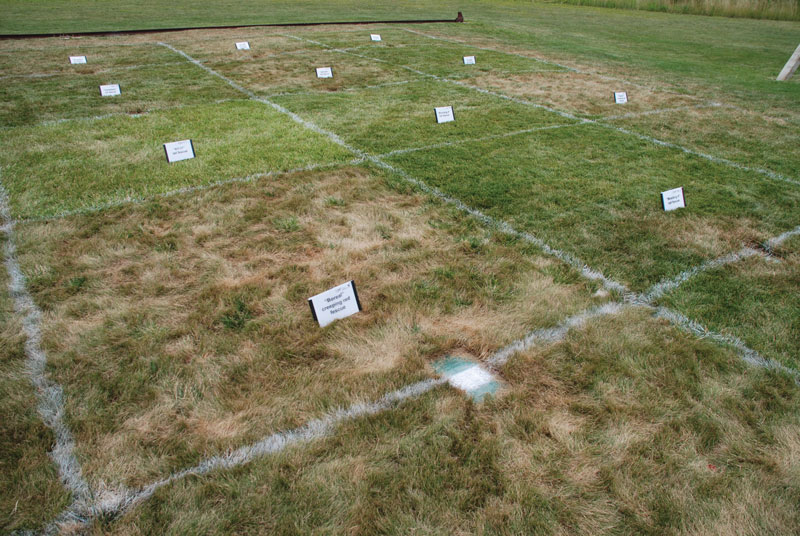
Figure 2. Irrigation trials at the University of Wisconsin’s O.J. Noer Turfgrass Research and Education Facility in Verona, Wis., were used to investigate differences in drought stress tolerance of fine fescue taxa. Photo by Aaron Patton
Drought
Drought survival mechanisms allow fine fescues to survive drought through tolerance (suspension), persistence (avoidance) or both (Table 1). When compared with other cool-season turfgrasses, fine fescues have been reported to have slower growth rates and lower water-use (evapotranspiration) rates, which can improve overall drought resistance (4).
One thing for golf course superintendents to keep in mind is that turfgrass species with better drought resistance do not necessarily use less water (2). For example, tall fescue (Festuca arundinacea, synonym Schedonorus arundinaceus, synonym Lolium arundinaceum), which is known for excellent ability to avoid drought stress because of its deep rooting, also has high water-use rates when water is plentiful (8). With this in mind, the drought resistance rankings of fine fescues listed in Table 1 may be a combination of multiple factors, such as slower growth rates, shorter plant canopies, lower water-use rates, etc.
Overall, when managed with little to no supplemental irrigation after establishment, fine fescues have been shown to perform as well, or better at times, than other cool-season turfgrass species across multiple sites and years in the north-central U.S. and a few sites in the transition zone (11, 12, 13). Hard fescue, sheep fescue and Chewings fescue have been some of the top performers in these experiments. In general, the relative drought resistance for sheep and hard fescue is excellent, followed by good to excellent resistance for Chewings fescue and slender creeping red fescue, and good resistance for strong creeping red fescue, with variation among cultivars (4) (Table 1, Figure 2).
Submersion
Another area where research is lacking is cool-season turfgrass tolerance to water submersion, such as poorly drained or wet/flooded soils. Researchers (1) reported slender creeping red fescue was the least tolerant to water submersion stress when compared with creeping bentgrass (Agrostis stolonifera), Kentucky bluegrass (Poa pratensis) and annual bluegrass (Poa annua); higher water temperatures were more detrimental in all four turfgrass species. Since that early report (1), little research has been conducted on water submersion stress with cool-season turfgrasses, especially fine fescues (4).
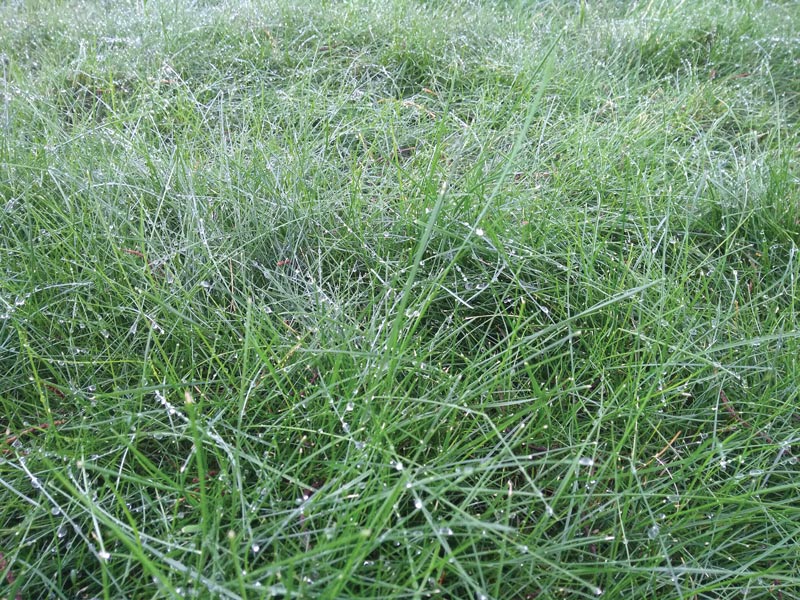
Figure 3. Poor tolerance of water submersion can be a major limitation for the use of fine fescues for concave, lower-lying areas; sites with poor drainage; and sites that receive high annual precipitation amounts or heavy rainfall. Photo by Ross Braun
Overall, all five fine fescues have been anecdotally associated with poor tolerance to wet or poorly drained soils, but personal observations by researchers have led us to suggest there may be differences in tolerance among the fine fescue taxa (4) (Table 1). Poor tolerance to water submersion can be a major limitation for the use of fine fescues for concave, lower-lying areas; sites with poor drainage; and sites that receive high annual precipitation or heavy rainfall (4). Further research is needed to understand the differences among fine fescue taxa to potentially support anecdotal observations of turfgrass managers and researchers.
Heat stress
During summer, cool-season turfgrasses are likely to experience heat stress when air and soil temperatures exceed optimal growing temperatures, typically above 86 F (30 C) (6). Although these periods of heat stress are commonly associated with periods of summer drought, they can also occur when soil moisture is adequate or excessive.
Performance during prolonged periods of summer heat stress is one of the major limitations of fine fescues, which generally receive a fair heat-stress-tolerance ranking when compared with other cool-season turfgrasses (6).
The good news is that research activity on heat stress tolerance in fine fescues has increased in the past five years. Researchers have reported genetic variability in heat stress responses among the five fine fescue taxa and cultivars, and identified plant cell membrane components and genetic markers, all of which may help aid marker-assisted breeding techniques to develop improved heat-tolerant fine fescue cultivars (9, 10, 14) (Table 1). In addition, as part of the USDA-NIFA grant, researchers at Rutgers and USDA-ARS are currently conducting experiments on heat stress and gene analysis to identify candidate genes related to heat tolerance and select heat-tolerant germplasm under field conditions.
Traffic stress
Traffic/wear stress is another major limitation of fine fescue use, especially in high-traffic areas during times of drought and/or heat stress (Figures 4, 5). Overall, fine fescues have been considered less traffic/wear-tolerant than other cool-season turfgrass species, but they are still able to tolerate moderate traffic, especially if growing conditions are ideal (4). This common belief that fine fescues show poor traffic/wear tolerance may be due to compounding factors in past research, such as including only one of the five fine fescue taxa to represent the entire group and/or evaluating traffic tolerance of fine fescues under suboptimal growing conditions (4).
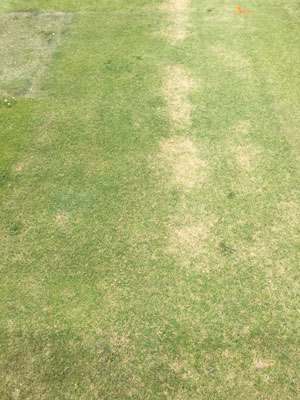
Right: Figure 4. National Turfgrass Evaluation Program tests in Minnesota show traffic/wear damage in hard fescue plots maintained at golf course fairway height. The left half of this plot received traffic from routine mowing, but the right half was treated with routine mowing and also subjected to simulated golf cart traffic. Photo by Eric Watkins
Differences in wear tolerance among the five fine fescue taxa and cultivars within a taxon do exist (4) (Table 1). Recent research has shown good wear tolerance with new and improved fine fescue cultivars compared with other cool-season turfgrasses on low-input golf course fairways in the north-central U.S., specifically Chewings fescue and sheep fescue (13).
Researchers at Rutgers University and the University of Minnesota have conducted numerous trials in the past 10 years to evaluate, screen potential mechanisms, and develop breeding techniques related to improved traffic/wear tolerance (3, 7) (Figure 4). Breeding programs continue to release cultivars of all five fine fescue taxa with improved wear tolerance, but similar trends in traffic/wear-tolerance differences remain (3, 7) (Table 1). As part of the USDA-NIFA grant, researchers at Rutgers, Minnesota and USDA-ARS are currently conducting field and genetic mapping experiments to develop fine fescue breeding populations with improved wear tolerance.
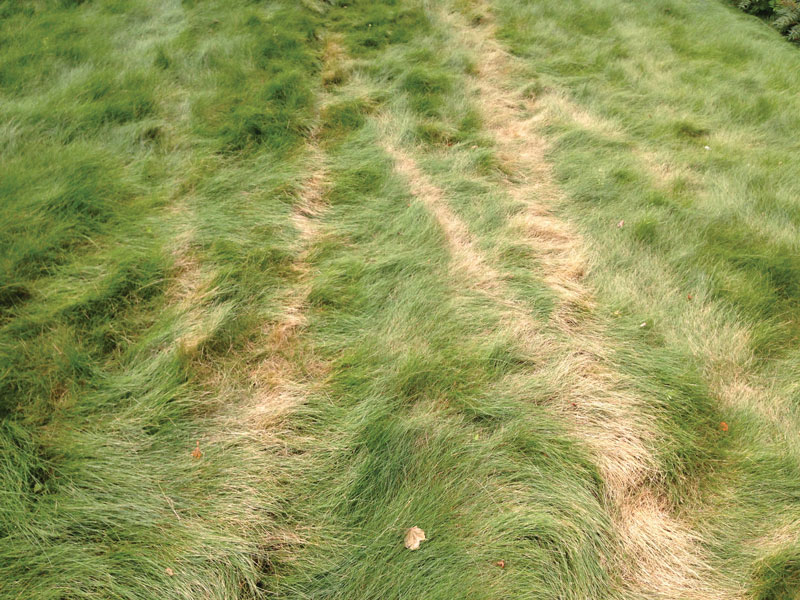
Figure 5. Summer cart traffic caused stress damage to no-mow fine fescue turf on the campus of the University of Minnesota. Photo by Sam Bauer
Salt stress
One advantage fine fescues have over other cool-season turfgrass is high tolerance to salt stress, although there is variation among the fine fescue taxa (4) (Table 1). Slender creeping red fescue generally has the highest salt tolerance among the fine fescue taxa, possibly because of the origin of this subspecies (4). The taxonomic classification of slender creeping red fescue is littoralis (Festuca rubra subspecies littoralis), which means “pertaining to the seashore,” and is used to describe species found in sand dunes, salt marshes or riverbanks. The subspecies name also accurately describes and represents slender creeping red fescue’s well-known salt tolerance and its natural habitat in maritime, estuary and dune locations (4, 5).
High salt tolerance makes fine fescues ideal for use along roadsides, sidewalks and golf cart paths treated with de-icing salts; golf course sites with saline soils; and golf courses that receive brackish or reclaimed water for irrigation (4). Fine fescues are also useful turf options for a variety of golf course soil conditions, including acidic soils (pH of 4.5 to 6.5) and reclaimed or contaminated sites containing toxic metals, such as zinc, lead, copper and nickel (4).
Shade stress
Another advantage of fine fescues is their high tolerance to shade stress, which is probably their most well-known characteristic (Figure 6). Past research has shown and confirmed again and again the superior shade tolerance of fine fescues compared with other cool-season turfgrasses (4).
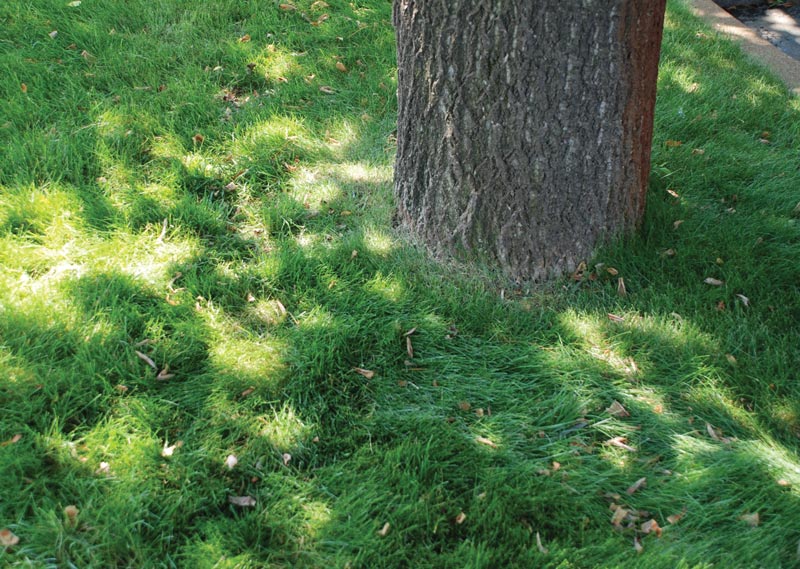
Figure 6. Fine fescue grows well under shaded conditions, as seen in this photo taken in Indiana. Photo by Aaron Patton
As with other abiotic stresses, shade tolerance varies among and within the five fine fescue taxa (Table 1). Chewings fescue has consistently shown the best shade tolerance, followed by, in order of decreasing tolerance, slender creeping red fescue, strong creeping red fescue, hard fescue and sheep fescue (4) (Table 1). The ability to survive shaded environments provides a clear advantage for fine fescue use over other turfgrass species in shade-stressed areas on the golf course.
Final comments
Like other turfgrass species that each have specific weaknesses, the fine fescues have shortcomings to specific abiotic stresses, such as poor tolerance to wet/flooded soils, heat stress and traffic stress. However, they also have many strengths, such as good drought resistance and salt and shade tolerance.
Researchers and breeders continue to investigate and improve resistance to these abiotic stresses, which may help expand the use of fine fescues into other turf areas on the golf course. It is important to recognize the weaknesses and strengths of each fine fescue taxon and understand the variation among the taxa (Table 1). With that in mind, golf course superintendents have the advantage of selecting either an individual fine fescue or a mixture of fine fescue taxa to help overcome and compensate for potential abiotic stresses on the golf course.
Fine fescues in upcoming issues of GCM
Information about differences in common biotic pests (weeds, diseases and insects) of fine fescues and about management will appear in the September 2020 issue of GCM. See our blog and follow us on Twitter and Facebook.
Funding
This work was funded by the National Institute of Food and Agriculture, U.S. Department of Agriculture, Specialty Crop Research Initiative (2017-51181-27222). The full manuscript is available through open access in Crop Science (https://doi.org/10.1002/csc2.20122).
The research says ...
- Fine fescues can succeed under low-input conditions; however, response and tolerance to different abiotic stresses (drought, submersion, heat, traffic, salinity, shade) varies among the taxa.
- Fine fescues have many strengths, such as good drought resistance, and salt and shade tolerance, but it is important to recognize their weaknesses, such as poor tolerance to wet/flooded soils, heat stress and traffic/wear stress.
- Researchers and breeders continue to investigate and improve resistance to these abiotic stresses.
Literature cited
- Beard, J.B., and D.P. Martin. 1970. Influence of water temperature on submersion tolerance of four grasses. Agronomy Journal 62:257-259.
- Bell, G.E. 2011. Turfgrass physiology and ecology: Advanced management principles. CAB International, Oxfordshire, U.K.
- Bonos, S.A., E. Watkins, J.A. Honig, M. Sosa, T. Molnar, J.A. Murphy and W.A. Meyer. 2001. Breeding cool-season turfgrasses for wear tolerance using a wear simulator. International Turfgrass Society Research Journal 9:137-145.
- Braun, R.C., A.J. Patton, E. Watkins, P. Koch, N.P. Anderson, S.A. Bonos and L.A. Brilman. 2020. Fine fescues: A review of the species, their improvement, production, establishment, and management. Crop Science 60:1142-1187 (https://doi.org/10.1002/csc2.20122).
- Clifford, H.T., and P.D. Bostock. 2007. Etymological dictionary of grasses. Springer-Verlag, New York.
- Fry, J.D., and B. Huang. 2004. Applied turfgrass science and physiology. John Wiley & Sons, Hoboken, N.J.
- Grimshaw, A.L., Y. Qu, W.A. Meyer, E. Watkins and S.A. Bonos. 2018. Heritability of simulated wear and traffic tolerance in three fine fescue species. HortScience 53:416-420 (https://doi.org/10.21273/HORTSCI12450-17).
- Qian, Y.L., J.D. Fry and W.S. Upham. 1997. Rooting and drought avoidance of warm-season turfgrasses and tall fescue in Kansas. Crop Science 37:905-910 (https://doi.org/10.2135/cropsci1997.0011183X003700030034x).
- Wang, J., P. Burgess, S.A. Bonos, W.A. Meyer and B. Huang. 2017. Differential physiological responses and genetic variations in fine fescue species for heat and drought stress. Journal of the American Society for Horticultural Science 142:367-375 (https://doi.org/10.21273/JASHS04121-17).
- Wang, J., H.R. Juliani, D. Jespersen and B. Huang. 2017. Differential profiles of membrane proteins, fatty acids, and sterols associated with genetic variations in heat tolerance for a perennial grass species, hard fescue (Festuca trachyphylla). Environmental and Experimental Botany 140:65-75 (https://doi.org/10.1016/j.envexpbot.2017.05.014).
- Watkins, E., S. Fei, D. Gardner, J. Stier, S. Bughrara, D. Li, C. Bigelow, L. Schleicher, B. Horgan and K. Diesburg. 2011. Low-input turfgrass species for the north-central United States. Applied Turfgrass Science 8(1):1-11 (https://doi.org/10.1094/ATS-2011-0126-02-RS).
- Watkins, E., D.S. Gardner, J.C. Stier, D.J. Soldat, R.A. St. John, N.E. Christians, A.D. Hathaway, K.L. Diesburg, S.R. Poppe and R.E. Gaussoin. 2014. Cultivar performance of low-input turfgrass species for the north central United States. Applied Turfgrass Science 11(1):1-7 (https://doi.org/10.2134/ATS-2013-0101-RS).
- Watkins, E., A.B. Hollman and B.P. Horgan. 2010. Evaluation of alternative turfgrass species for low-input golf course fairways. HortScience 45:113-118.
- Xu, Y., J. Wang, S.A. Bonos, W.A. Meyer and B. Huang. 2018. Candidate genes and molecular markers correlated to physiological traits for heat tolerance in fine fescue cultivars. International Journal of Molecular Sciences 19(1):116 (https://doi.org/10.3390/ijms19010116).
Ross C. Braun is a lead research scholar, and Aaron J. Patton is interim department head and a professor in the Department of Horticulture and Landscape Architecture at Purdue University, West Lafayette, Ind. Eric Watkins is a professor in the Department of Horticultural Science at the University of Minnesota, St. Paul, Minn. Paul L. Koch is an associate professor in the Department of Plant Pathology at the University of Wisconsin, Madison, Wis. Nicole P. Anderson is a field crops Extension agent in the Department of Crop and Soil Science at Oregon State University, Corvallis, Ore. Stacy A. Bonos is a professor in the Department of Plant Biology and Pathology at Rutgers University, New Brunswick, N.J. Leah A. Brilman is the director of product management and technical services at DLF Pickseed USA, Halsey, Ore.